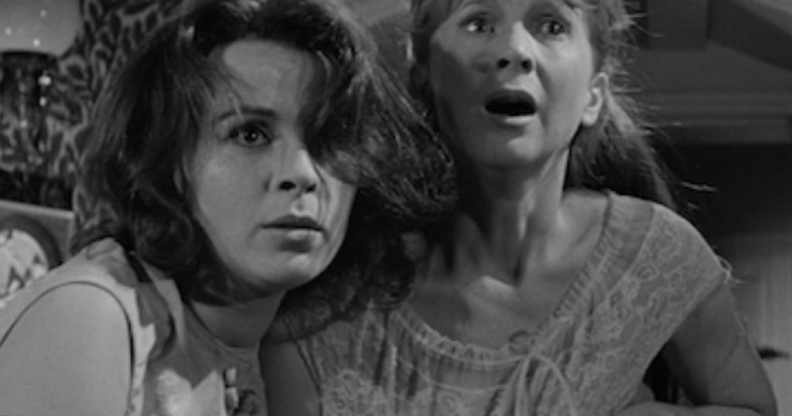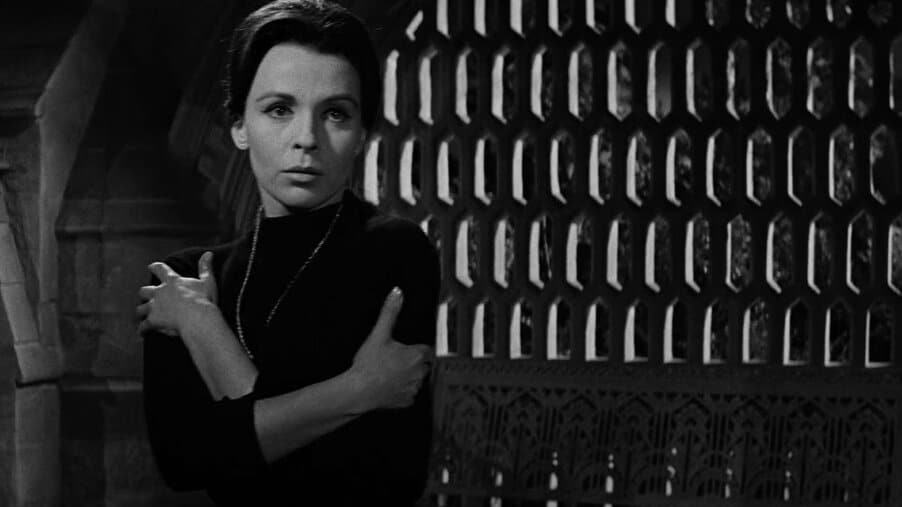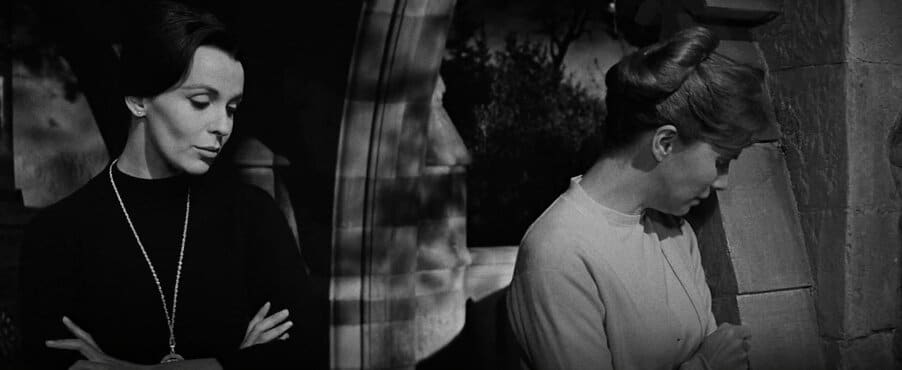How iconic 60s horror film The Haunting broke the mould by putting queerness front and centre

Theodora and Eleanor in The Haunting. (Metro-Goldwyn-Mayer)
In the 1960s, people weren’t generally accustomed to seeing LGBT+ representation on screen. The Haunting, for many, changed that.
The film, released in 1963, has gone down in history as one of the greatest horror films ever made. Based on the acclaimed novel The Haunting of Hill House by Shirley Jackson, it follows a group of people who descend on a supposedly haunted house for a supernatural experiment. Ultimately, The Haunting was only a modest success at the box office, with some cinema-goers disappointed by a film that relies more on atmosphere than jump scares.
Despite this, The Haunting has endured as a classic of the genre – Martin Scorsese once placed it at number one on his list of the best horror films of all time.
But that isn’t The Haunting’s only claim to fame – it also has a special significance among queer horror fans because of its lesbian character Theodora, played by Claire Bloom.
If the film was made today, it wouldn’t exactly win any awards for queer representation. However, it’s important to remember that 1963 was a very different time. The Stonewall riots had not yet happened. The queer community remained, for the most part, underground, away from mainstream society.
The Haunting was groundbreaking in its depiction of Theodora as a lesbian
The Haunting got plenty wrong when it came to exploring Theodora’s sexuality – but it also got a lot right, which is one of the reasons the film remains so culturally significant.
For one, Theo is not depicted as a predator – a victory in itself for the 1960s. When LGBT+ characters appeared on screen, it was usually to tell audiences unequivocally that being gay was a type of sickness or disorder that needed to be overcome. But The Haunting never went to the same lengths to condemn Theo’s sexuality.
There is one particularly famous scene in which Eleanor, played by Julie Harris, turns to Theodora and suggests that she’s “unnatural”. Anybody who understood the language of the day around homosexuality would have known what she was alluding to. But that line marks the only time the film appears to directly confront Theo’s sexuality as a threat.
Fans of The Haunting will know that the film follows Eleanor as she experiences a mental breakdown as a direct result of of being in Hill House. It’s significant that Theodora has no such experience. Queer people were so often depicted as mentally ill in films of the same era, so the fact that Theodora makes it through the film with her sanity apparently completely intact was groundbreaking in itself.
The film was originally supposed to take Theodora’s queerness even further
The Haunting’s depiction of Theodora’s queerness was remarkable for the time – but the plan was originally to take it even further. When actress Julie Harris originally received the script, there was a scene in which Theodora was shown in her apartment. The scene made it even clearer that she was a lesbian and that she was in a relationship with another woman.
In that original scene, it was made clear that Theodora had just broken up with her girlfriend. The words “I hate you” could be seen written on a mirror in lipstick while Theo shouted out the window.
Ultimately, director Robert Wise decided to cut the scene. He felt that The Haunting worked hard to make things implicit – and he worried that the scene would make Theodora’s sexuality too explicit.
As was often the case at the time, film censors also waded into the film to make sure it wasn’t going to take things too far when it came to queer representation. At that time, film censors wielded significant power when it came to what filmmakers could and couldn’t do. They had the power to cut entire sections out of films, and they would routinely warn directors to stay away from certain topics and themes that would be seen as morally contentious. Unsurprisingly, LGBT+ identities were frequently cut from films as a result.
With The Haunting, Harris has said film censors demanded that Theo never be shown directly touching Eleanor as they felt this would make her lesbianism too explicit. Notably, the film actually does show the women touching and holding each other on a number of occasions. It’s not entirely clear how those scenes made the final cut – perhaps it was the way they were framed. There is a gentle suggestion in The Haunting that Theodora might have some kind of romantic or sexual feeling for Eleanor, but the idea is never really expanded on.
Claire Bloom is still proud of having played a lesbian character to this day
Bloom has spoken on a number of occasions about her pride at playing a lesbian character in The Haunting. In an interview released by The Motion Archive, she said she felt that Wise was right to cut the scene in the original script which made her character’s lesbianism more explicit.
Her character was “very obviously gay” in the original script, she said. “It kind of set up, I thought, her character very well. You see her at the house and she has a background, but in fact Rob Wise chose to edit that from the film, and of course he was absolutely right, as he would be, as a great editor and a great director, because it made the entrance of Theo so much more mysterious.”
She continued: “In fact, you didn’t know anything about her, rather than knowing this heavy handed stuff about her that was originally in. At first I was disappointed, but when I saw the film itself I realised, of course, how correct he was.”
However, in a 2021 interview with the British Film Institute (BFI), Bloom appeared to express some dissatisfaction with Theodora’s character in the film, saying she was “very linear”.
“The character’s lesbianism was made more obvious in the original script… But I know that the film is highly appreciated. Personally, I think Psycho (1960) or The Shining (1980) are much more frightening,” she added.
The Haunting casts a long legacy over the horror genre to this day
The Haunting is well regarded for shaking up the horror genre. The film is, in many ways, timeless – it continues to thrill audiences to this day.
It has also inspired countless filmmakers and writers to repeatedly return to Hill House to enliven the story for a new generation. In 1999, The Haunting got the remake treatment with Liam Neeson, Lili Taylor and Owen Wilson starring.
Catherine Zeta Jones took on the role of Theodora – but the character’s queerness was nowhere near as notable as in the original. Instead, the film presented Theodora as sexually lascivious and possibly bisexual, but overall, it was a disappointing moment for queer horror fans. Not only was the film awful, it also showed that queer representation in Hollywood was still falling far behind where it should have been more than 30 years on from the release of The Haunting in 1963.
The character was brought to a new audience again with the Netflix series The Haunting of Hill House. When the limited series landed on the streaming platform in 2018, it immediately became a sensation – largely because it was very, very scary.
The Haunting of Hill House was also very different from the 1963 film – it instead recast the characters as members of a dysfunctional family who had a traumatic childhood in Hill House. In this, Theodora was noticeably and unabashedly queer.
It was a full circle moment for queer horror fans, who had waited many years to see meaningful queer representation in the genre. It’s probably not the last time The Haunting of Hill House will be adapted for the screen, either – the story is endlessly fascinating, and audiences are still gripped by one of the best haunted houses in film history to this day.



